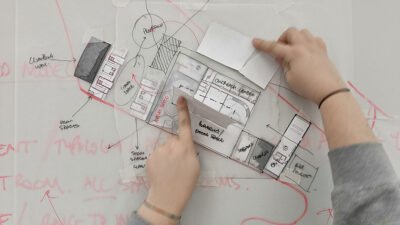Embarking on a career in architecture requires a substantial investment of time, energy, and financial resources. It often entails a lengthy educational journey, sometimes extending beyond five years, especially if the goal is to become a registered architect. This commitment surpasses mere academic pursuit, impacting potential earnings and demanding significant dedication. Aspiring architects must grasp the depth of this commitment early in their journey, as it shapes their understanding and expectations of the architectural practice.
Your Role in Different Architectural Practices
In architectural firms, the practice size significantly influences your role and responsibilities. In a large global firm, entry-level architects often start with less desirable tasks, facing a rigid hierarchy. However, these firms can provide exposure to large-scale projects and robust business systems. Conversely, in smaller practices, while the projects may be less grandiose, the roles are more diverse and hands-on, offering a steep learning curve. Understanding these dynamics is vital for architects to align their career aspirations with the right firm size.
Understanding Project Types and Typologies
The variety of projects an architect works on can range from glamorous high-rises and cultural buildings to more utilitarian structures like industrial sheds. Each project type, whether a master plan for a school or a residential development, presents unique challenges and opportunities for creative problem-solving. Architects need to be open-minded and not limit themselves to only certain types of glamorous projects, as each brings valuable experiences.
Navigating the Scale and Duration of Architectural Projects
Architectural projects vary greatly in scale and duration. Unlike academic projects that last a semester, real-world projects can span years. Large-scale projects involve working within a team on specific aspects, while smaller projects might offer more comprehensive roles but with faster turnaround times. Understanding and adapting to these variations is key to managing expectations and excelling in project delivery.
Financial Realities in the Field of Architecture
It’s essential to recognize that monetary compensation in architecture may not always reflect the effort and time invested, especially in the initial stages of your career. However, with experience and advancement to higher positions like senior associate or director, the financial rewards can be more significant. For those running their practice, business acumen is just as important as architectural skills in ensuring profitability.
The Challenges of Running Your Own Architecture Firm
Starting and managing your own architectural firm involves more than just design skills; it requires business management and marketing expertise. Early in your career, you might juggle side projects while working full-time, and be prepared to take on varied jobs to build credibility. Learning the ropes of business management is crucial for the success of your practice.
Comparative Table: Large vs. Small Architectural Firms
| Aspect | Large Architectural Firms | Small Architectural Firms |
|---|---|---|
| Role of New Architects | Often start with foundational tasks, limited autonomy. | Diverse roles, more hands-on experience from the start. |
| Project Scale | Typically work on large-scale, high-profile projects. | Focus on smaller, more localized projects. |
| Learning Opportunities | Structured learning, exposure to large project dynamics. | Rapid learning in a versatile environment. |
| Personal Growth | Specific roles may limit exposure to the full project scope. | Opportunities to engage in a project’s full lifecycle. |
| Team Structure | Clear hierarchy, working in large teams. | Flatter structure, closer collaboration with senior architects. |
Key Bullet Points for Aspiring Architects
- Adaptability: Be prepared to adapt to various roles and responsibilities;
- Continuous Learning: Embrace continuous learning and skill development;
- Networking: Build professional relationships within the industry;
- Time Management: Develop strong time management and organizational skills;
- Design Diversity: Be open to working on a variety of project types;
- Technology Proficiency: Stay updated with the latest architectural software and tools;
- Financial Awareness: Understand the economic aspects of architectural projects;
- Business Acumen: For those interested in running their firm, cultivate business and marketing skills.
The Architect’s Evolution: From Graduate to Professional
The transition from an architecture student to a professional involves more than just a title change; it is a significant evolution in responsibility and skill. As graduates enter the workforce, they often start with foundational tasks in large firms or diverse roles in smaller practices. This period is crucial for developing a strong professional foundation. Graduates learn to navigate complex project dynamics, understand client needs, and refine their design skills. Over time, as they gain experience, their responsibilities increase, and they start to play a more pivotal role in projects.
This journey from a novice to a seasoned architect is marked by continuous learning, adaptability, and a growing understanding of the intricate balance between artistic vision and practical functionality in architecture.
Navigating Financial Realities and Career Progression in Architecture
Understanding the financial landscape of the architectural profession is vital for career progression. Initially, the monetary compensation may not reflect the intensity of the work, but this changes with experience and advancement into senior roles. Architects must navigate budget constraints and economic factors that influence project designs and outcomes. Those aspiring to run their firms need to develop business acumen alongside their design skills.
This includes understanding client acquisition, project budgeting, staff management, and marketing. Successfully balancing these aspects leads to not just financial rewards, but also professional satisfaction and the ability to influence the built environment significantly.
Crafting an Effective Weekly Plan: A Practical Guide for Architecture Students
Developing a weekly plan is a critical skill for architecture students, balancing academic obligations with personal pursuits. This section provides a pragmatic example and approach to crafting a weekly schedule that promotes productivity and well-being.
- Structuring Your Week: Begin by plotting your fixed commitments such as classes, work hours, and regular activities. This forms the framework of your weekly plan. For instance, if classes are scheduled on Monday, Wednesday, and Friday mornings, these times are non-negotiable study periods;
- Incorporating Study Sessions: Allocate specific blocks for independent study, project work, or group meetings. For example, Tuesday and Thursday afternoons can be dedicated to project development or software learning;
- Balancing Personal Time: Ensure to schedule time for meals, exercise, and relaxation. Maintaining a healthy lifestyle is crucial for sustained productivity. For instance, evenings might be reserved for relaxation or social activities, while weekends can include time for hobbies or personal projects;
- Adapting for Deadlines: Be flexible to adjust your plan during weeks with major submissions or reviews. This might mean dedicating more time to specific projects or seeking study groups for collaborative work.
Example of a Weekly Plan:
- Monday: Classes (9 AM – 1 PM), Lunch Break (1 PM – 2 PM), Study Session (2 PM – 5 PM), Evening Free;
- Tuesday: Independent Study (10 AM – 1 PM), Project Work (2 PM – 5 PM), Exercise (5:30 PM – 6:30 PM);
- Wednesday: Similar structure to Monday;
- Thursday: Similar structure to Tuesday;
- Friday: Classes (9 AM – 12 PM), Group Meeting (1 PM – 3 PM), Weekend Planning (3 PM – 4 PM);
- Saturday: Personal Projects/Hobbies, Social Activities;
- Sunday: Rest, Review Upcoming Week, Prepare for Monday.
Conclusion
A career in architecture is both challenging and rewarding, offering continuous opportunities for growth and learning. Embracing this journey with an open mind and a willingness to adapt can lead to a fulfilling and successful career in the field. Remember, architecture is as much about the process as it is about the final product.











